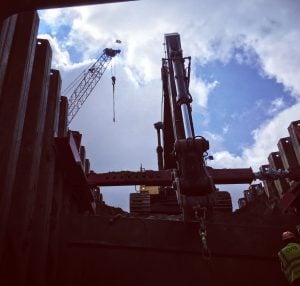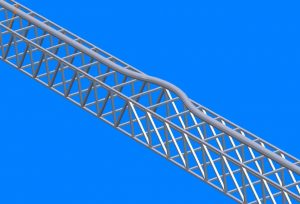A description of proper scaffold bracing techniques for power plant boilers and similar industrial applications.
When it comes to scaffold bracing, when is there enough bracing? Certain untrained erectors, and users, assume that if the scaffold isn’t falling down, then there is enough bracing; not a very smart, practical or safe approach. And then there is the question of what type of bracing are you talking about? Is it stability bracing, bracing that keeps the scaffold from falling over, or is it the bracing that gives a supported scaffold its’ strength?
Stability bracing typically includes the connection to an adjacent structure to make sure the scaffold stays erect. Strength bracing is the bracing that is necessary to make sure the scaffold legs can support the anticipated load that will be applied to them. Strength bracing can take several forms, depending on the type of scaffold and the design chosen by the qualified designer. For example, a tubular welded frame scaffold uses cross braces for bracing. A cross brace consists of two tubular or angular lengths of metal connected at the middle to form an “x”. The four ends of the brace have holes so the brace can be connected in four locations by sliding the holes over pins welded to the frame legs. This is called a pin connection. For systems scaffolds, bracing is accomplished by using a single diagonal member that is connected to adjacent legs in a vertically diagonal direction. The connection is a rigid connection rather than a pinned connection. However, the bracing effect on each accomplishes the same goal which is to make sure the scaffold leg can support the anticipated load.
A major factor in the strength of a supported scaffold leg is what engineers refer to as the “unbraced length.” A scaffold of a given diameter and material will support decreasingly smaller loads as the unbraced length of the leg gets longer. In other words, a tube 12 inches long will support a lot more load than a tube 12 feet long. When it comes to systems scaffolds, the standard unbraced length is typically 6’-6” (for systems scaffolds based on the metric system). In other words, scaffold erectors are used to installing horizontal runners every fourth connection point on the leg, resulting in an unbraced length of 6’-6”. And this is what should be done. But the bracing doesn’t end with providing a horizontal support every so often. Without some kind of additional bracing, the scaffold will simply deflect sideways, resulting in a catastrophic collapse.
This additional bracing can be either vertical diagonal bracing or other bracing that provides equivalent support, such as an adjacent scaffold or an adjacent structure. Take, for example, a power plant boiler. For those of you not familiar with a power plant boiler, picture a half gallon milk carton upside down with the “vee” shaped top now at the bottom. Picture the milk carton 175 feet high, 100 feet long and 60 feet wide. (That’s like the height of the Statue of Liberty!) Now, scaffold the interior of the milk carton using systems scaffold utilizing a 30” diameter access opening in the bottom of the milk carton. Hey, nobody said boiler scaffolds were easy to construct.
When the qualified designer chooses bracing for a scaffold in this situation, she can use diagonal bracing, the boiler walls, or a combination of the two to provide the required lateral support for the legs. As you can imagine, just the weight of the scaffold will exert a considerable load on each scaffold leg. In other words, the bracing is critical to the success of the design. If vertical diagonal bracing is chosen by the designer, the design is straightforward. Typically, the diagonal bracing is installed every fourth bay (depending on the manufacturer) and in both directions. Remember, a scaffold in an upside down milk carton is three dimensional, in other words, multiple bays wide and multiple bays long.
An alternative bracing scheme is to use the walls of the boiler for the bracing. This is effective when the bracing is designed properly, installed according to the design, and not tampered with by the scaffold user. This is critical since using the boiler walls effectively requires the legs to be “bumped” against the opposite walls of the boiler. In other words, a continuous line of horizontal runners must extend from wall to wall with bump tubes against the wall at each end. There is no room for error in this type of bracing since removal of a single bump tube will immediately affect the unbraced length of the scaffold leg and instantaneously decrease the capacity of the scaffold leg, possibly resulting in a catastrophic failure. (If the individual tampering with the bracing is lucky, the resulting failed scaffold will wedge against the walls of the boiler, avoiding a catastrophic collapse which would kill the misbehaving scaffold user and his fellow employees.)
The bottom line here is that bracing is critical for the ability of a supported scaffold to support a load. Whether diagonal bracing is used for a systems scaffold or whether another structure is used to provide the bracing doesn’t matter as long as it is done correctly.
It is up to the designer and erector of the scaffold to get it right. That is why we have standards and regulations that require that scaffolds be designed by a qualified person, an individual who knows what he/she is doing. And of course, we expect the scaffold to be constructed accordingly to the design (we have a regulation for that too). And finally, we don’t want users messing with the scaffold (yep-there’s a regulation for that too), especially if it’s inside an upside down milk carton!













